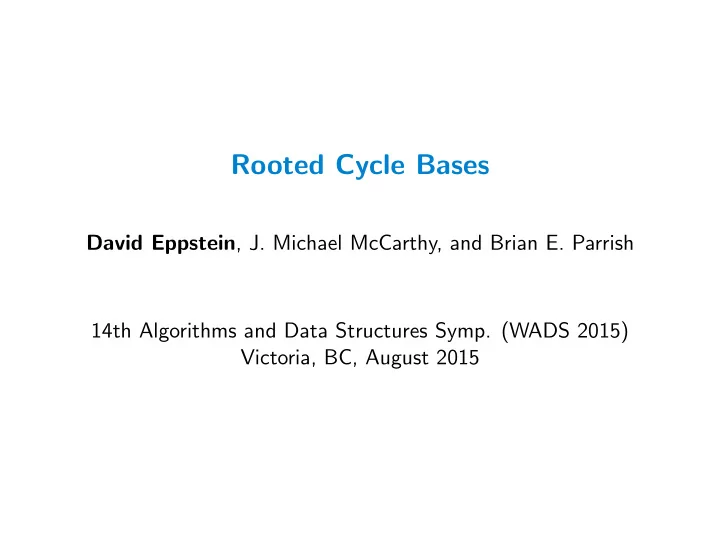

Rooted Cycle Bases David Eppstein , J. Michael McCarthy, and Brian E. Parrish 14th Algorithms and Data Structures Symp. (WADS 2015) Victoria, BC, August 2015
Linkages Systems of rigid bodies connected by hinges Often with designated ground body (fixed in place) and input body (where force input causes system to move) A B A B In E C D In C D E F H J F J H Gd Gd Connectivity may be described by a graph with vertices = bodies and edges = hinges Simplifying assumptions: system lies in R 2 (crossings allowed); input is attached to ground (so its motion is purely rotational)
Complex linkages can have complex motions CC-BY-SA image of Amanda Ghassaei Walker by diehart, http://www.thingiverse.com/thing:264726 Applications include walking robots, fold-away sofabeds, vehicle suspensions, low-clearance doors, therapeutic exoskeletons, . . .
Our piece of a larger puzzle Goal: design linkage that achieves some desired motion Sub-goal: Analyze motion of a linkage Sub-sub-goal: Set up independent equations for the motion of a linkage CC-BY image “Close up of Hand Cut Jigsaw Puzzle” by Charles Hamm on Wikimedia commons Combinatorial abstraction: Find independent input–ground paths in the graph of a linkage
Independence of cycles in graphs Cycle space: a vector space over Z 2 Elements = sets of edges with even degree at all vertices Vector sum = symmetric difference of edge sets Scalar product = trivial → Based on CC-BY-SA image “Cycle space addition” by Kilom691 on Wikimedia commons
Cycle bases Cycle basis = basis of the cycle space = maximal independent set of cycles Fundamental cycle basis: In planar graphs, cycles are spanning tree bounded faces form paths + one edge a cycle basis
Greed is good Independence in a vector space forms a matroid ⇒ minimum weight cycle bases can be found by a greedy algorithm For each candidate cycle, sorted by weight, test if independent and, if it is, include in basis The difficult part: finding a small set of candidate cycles Avarice, from The Dunois Hours, France, ca. 14401450. Public domain When all weights positive, image “The Dunois Hours Avarice” on Wikimedia commons. possible in polynomial time
What kind of cycle basis do we need? Paths from linkage input to ground ⇔ cycles that all pass through a “root edge” incident to input and ground Rooted graph: undirected graph + one chosen root edge Rooted cycle basis: all cycles in the basis include the root edge Higher cycle length gives more Plate to: H. J. Ruprecht, wand-atlas, ed. 3, Dresden, c. 1850, no. 15. Public complex equations to solve, so domain image “A plant root cut to show growth rings, wood cells in longitu we want a minimum weight Wellcome V0044550” on Wikimedia commons. rooted cycle basis
Warm-up result Rooted cycle basis exists if and only if graph has one non-trivial 2-vertex-connected component and it contains the root edge Proof uses ear decomposition: ◮ Sequence of simple paths ◮ First path = root edge ◮ Endpoints of remaining paths lie on earlier paths ◮ Interior vertices of each path are disjoint from earlier paths Proof idea: Extend each ear to rooted cycle through previous ears
The main result Polynomial-time construction of min-weight rooted cycle basis Main idea: new edges of each greedy basis cycle form one path; these paths form an ear decomposition P Part of case analysis f s showing that a cycle v Q 2 with > 1 new-edge Q 1 C i paths cannot be the greedy choice A i – 1 t 1 t 2 Corollary: shortest rooted cycles through each edge form a valid candidate set Use Suurballe’s algorithm to find these cycles
Breaking ties Correctness proof is only valid when all cycle lengths are distinct Small random perturbation works but requires randomness Perturbation by small powers of two works but requires too many bits of numerical precision Data structure for simulating power-of-two perturbation incurs only logarithmic slowdown 0 0 abdf 0 bdgh 0 abfg 1 2 1 abd 1 bd 1 ab 2 f 2 gh 2 fg 3 4 5 6 3 ab 3 b 4 d 5 f 6 gh 6 g a b c d e f g h a b c d e f g h
Additional results Finding a fundamental rooted cycle basis is NP-complete (planar dual of finding a rooted Hamiltonian cycle) But can be solved in fixed-parameter time for (nonplanar) graphs of small treewidth or clique-width using Courcelle’s theorem
Conclusions New type of cycle basis Motivated by applications in linkage analysis With a polynomial time optimization algorithm Also useful for other applications?
Recommend
More recommend